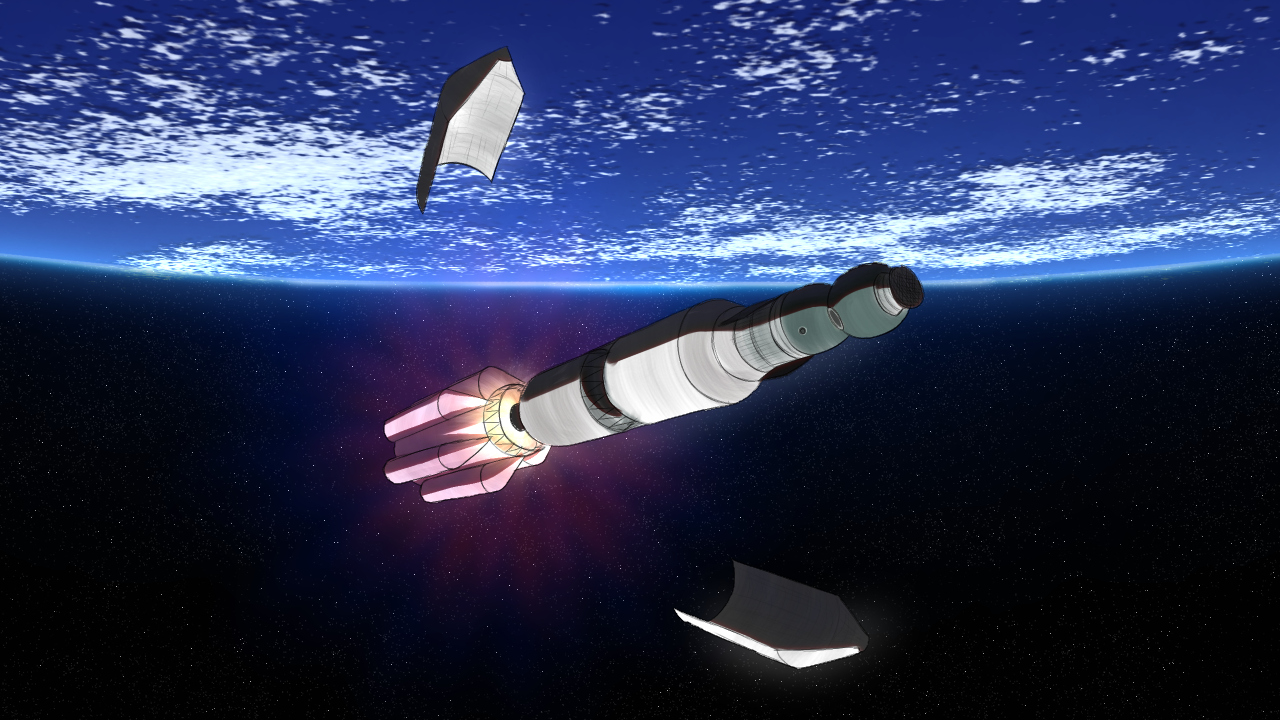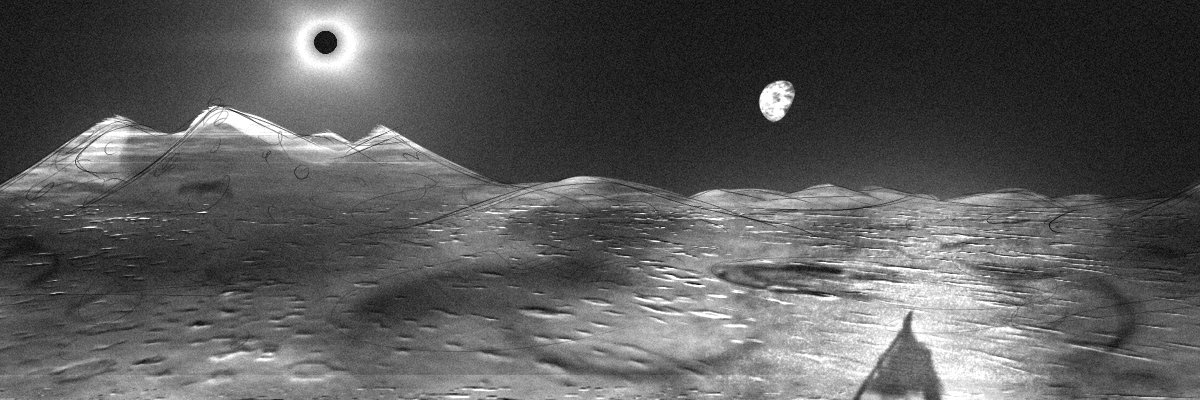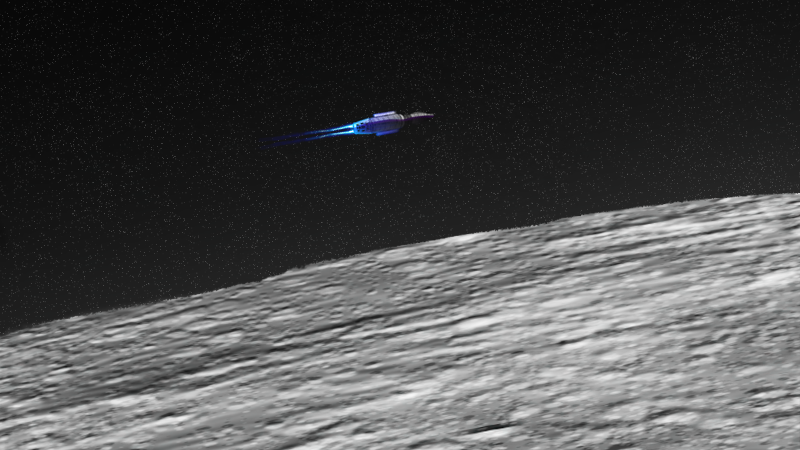Chapter 12 - Convergence
October 28, 1967
Yet again, the world was stunned hearing the news. The Soviets are going to Jupiter? How did they beat us? When are we going? What’s next? The Asteroids. The USSR had no asteroid missions planned yet, leaving this as perfect ground for exploration. And luckily, Dr. John Nicolaides would get his way once again, with help from Dandridge M. Cole. Seafarer 4, a larger probe than any seafarers launched before, rose from the launchpad, millions of eyes upon it, watching it fade away into the atmosphere. It sends its telemetry back as it goes further and further, finishing its injection burn. Its target, most people have not heard of, for there is nothing wholly unique about it - the asteroid 21 Lutetia. A main belt asteroid about 200 kilometres across, with little else known about it besides that. This was the first object to be visited, that we truly knew nothing about. Just a lone rock floating in the abyss, is it round? Rugged? Craterred? Smooth? There's only one way to find out, and one time, July 1969. Such is the agony of exploring beyond Mars, the distances increase exponentially, but thankfully, so do the scientific rewards.
In the past few years, Cole had continued to workshop various asteroid exploration missions, and had even begun to get funding to construct a small planetoid surveying observatory in Colorado, planning on opening in mid-1969. One bold mission idea of his was a crewed mission to the asteroid 1620 Geographos. It would be undertaken before a voyage to Mars, sometime in the 1970s. Taking only one or two Saturn V launches, delivering a crew of 3 to the asteroid for a number of weeks, performing a flyby around Venus to match inclinations. So far, he had spent months planning the designs, and it was getting close to being finished.
November 11, 1967
Floating towards the Moon, a cylindrical spacecraft, with 3 people sitting inside. This is Apollo 6, with Commander Walter Schirra, previously flying on Mercury-Vulcan 8 and Gemini 8. Command module pilot Jack Swigert, with this being his first flight, and Lunar Modular Pilot (Though there was no LEM), Walter Cunningham, also a newbie to NASA. As they sat in their chairs, two days from the moon, 100,000 kilometres above the Earth, they began to wake up for the day to Dream World by The Monkees, played by CAPCOM back on Earth.
Swigert “Darn. I was enjoying my dream world... Morning, Houston.”
CAPCOM “Mornin’! How’s the view, Columbiad?”
Swigert “Lots of stars. Can’t count ‘em all, but it looks like there's at least 12, probably more.”
CAPCOM “Got those same numbers down here too, you must be going the right way!”
Schirra “Morning, Houston.”
CAPCOM “Morning! Seems like most of y’all are up now, should we go through the day’s tasks?”
Cunningham “Might as well, whats first?”
CAPCOM “First make sure the star trackers are working, then a few observations of Earth and the Moon, then you’ve got an interview around 1600. That’s about it, it’s a pretty light day.”
Swigert “Well that sounds alright.”
CAPCOM “Don’t get used to light days, they’re a nice break but those heavy days are... Well, you’ll know tomorrow.”
Cunningham “Oh yeah we’re going to the Moon, aren’t we!”
Schirra “Definitely going to /a/ Moon. It's ours, right CAPCOM?”
CAPCOM “Ah, was that the plan? Sorry, boys, we’ve got y’all going to Ganymede!”
Cunningham “Won’t be the first time I’ve accidentally ended up there.”
Swigert “Happens to the best of us.”
The last peaceful day comes and goes, the Moon growing larger beyond the spacecraft, though they wouldn’t get their first view until tomorrow morning. As they wake up, the Moon is magnificent outside, vast sheets of bright dust layered on cooled lava flats, mountain ranges and craters. They’d seen the images

before of course, but this was different, this was real. They recorded it with their cameras, thousands of photographs, every crater they could see. After a few hours, Earth vanished behind the limb of the Moon, and the Sun was soon to follow. The term “Dark side of the Moon” is a misnomer, the Moon is tidally locked to Earth, only presenting one face, but this doesn’t mean the other is dark. During this flyby, the eastern hemisphere of the Moon is illuminated perfectly, extending slightly into the far side. At this moment it dawns on the crew, they are the first humans to see the far side of the Moon with their own eyes. Half a world so close to us, never before witnessed by a single soul.
They emerge from behind the Moon, Earth hearing their voices again, overjoyed to know they’re ok, and they begin to prepare for returns. Apollo 6 shoots away from the Moon before falling towards Earth, a bittersweet final 2 days in space before the landing. They all hope they can all go back someday, walk on its surface, see that beauty up close. They land in the ocean, recovered by the designated ship, and are hailed as heroes. The first humans to travel to and around the Moon.
November 16, 1967
The Surveyor program is one defined by taking risks, being adventurous, and pushing the envelope. For their next mission, Surveyor II-III, they had a new daring target to attempt a landing at: Hadley Rille. A large snaking depression in the lunar surface, and a geological marvel. Surveyor, currently hurtling towards its floor at breakneck speeds, would be attempting a landing here. Slowing down with its engines, it transmits live footage back, showing the boulder littered rille, and a small clearing. Mission control waits for confirmation of landing, and for ten seconds, the room falls completely silent. Then, the signal. They did it, Surveyor was down, and they could begin the science.
December 4, 1967
Across the nation, TV screens light up with a familiar face, Walt Disney. For the past few months, Walt was bedridden, in what is now a frequent occurrence, an unmissable sign of his declining health. For now, he’s well enough to appear on camera once more, for he has something to announce. The full plans for EPCOT, a massive planned community of people southwest of Orlando, Florida. It was a grand plan, a new, larger Disneyland, an airport, a monorail, hotels, vast green spaces, and a nuclear reactor to provide power. Full construction was to begin in under 3 years.
December 23, 1967
They were getting desperate. Confident in their ability to beat America to the moon, but still desperate. The N1 wasn’t ready for crewed flights yet, having flown 5 times, failing twice. Korolev had been given demands to send crew into Lunar orbit before the year was out. This was abysmal to plan, but it had been worked out - a LOK Soyuz would be placed atop a Proton rocket. It had launched enough to prove itself as being safe, and was the only other rocket capable of sending crew to the Moon. Atop the rocket, within the capsule, sat two brave cosmonauts. Yevgeny Khrunov, previously flying on Voskhod 7, and Andriyan Nikolayev, last flying on Vostok 3.

Proton lifted off, quickly placing the two brave cosmonauts on a path to intercept the Moon in four days. During the time, they do few experiments, mostly having the time to themselves. Then, as the Moon grows larger and larger, exceeding Earth’s visual size, a frenzy of activities hits. As many observations as they can make, every crater, mare, and hill they can see. Then, as they dip behind the Moon’s horizon, they turn on the engine. 40 minutes later, back in view of Earth, they give the confirmation.
“Archangel is in orbit!”
Mission control claps with such thunderous applause, it could be mistaken for a rocket launch. State media quickly announces the incredible news, and this makes its way across Europe, and Asia, and America. The USSR is the first nation to place humans in lunar orbit. They weren’t the first to reach it, no. But they would be the first to stay, at least for a little while. For the next few days, they map the lunar surface, taking photos of themselves in front of the far side of the Moon, and several spacewalks are performed, deploying a small satellite, Mechta-14. Their time around our celestial companion comes to an end, and Archangel burns for home. January 2, 1968, Archangel strikes the atmosphere, streaking a burning trail across the bare desert sky. Beyond this violent plasma, a few minutes later, the capsule gently touches down in the Kazakh plains. They’d gone to the Moon, stayed, and come back. Next time will get even closer.
January 18, 1968
The Soviets beat them to orbit. Goddamn it. They had nothing in store to one-up them this time. Just another orbiting mission. Jim Lovell, Frank Borman, and Buzz Aldrin sat within the capsule. One would think they would be crestfallen, at least the reporters did, but they were quite happy. Sure, they would no longer be first in lunar orbit, but they would still be going to lunar orbit! That’s nothing to scoff at. And so as the Saturn V launches with crew for only the second time, the three astronauts keep their hopes high, glancing at the Moon as the abort tower flies off into the distance, and their capsule is in Earth orbit. Their S-IVB ignites a second time, propelling Apollo 7 off into cislunar space, arriving at the Moon only three days later. Odyssey began to orbit the Moon, and much like the previous Archangel, they photographed the lunar surface and performed experiments. Unlike their soviet counterparts, they had multiple interviews with the news, limited by their orbits. This of course upset the scientists, wanting to focus on the actual mission, not just publicity. After two days in lunar orbit, Odyssey ignited her engine once more, propelling her back to the Earth. Another few days later, January 26, Apollo 7 splashes down in the Pacific ocean.
February 11, 1968
Two weeks ago, a meeting was held on how to proceed with the next Surveyor mission, II-IV. Its original landing site, Mare Fecunditatis, had been eclipsed by more intriguing targets. Some still advocated for it, more still for landing in the flat base of Messier A. Though these were incredibly intriguing landing sites, Lunar Orbiter 5’s reconnaissance had provided an interesting possibility - The poles. Some theorised that regions deep within craters that never saw the light of the sun could possibly contain frozen ice and volatiles. Such resources, if present on the surface, would be able to kickstart the colonisation of the Moon. From the few images returned, the south pole appeared to be a rugged nightmare, which, although landings had so far been successful in risky terrain, Surveyor II-I’s landing had cast a shadow of doubt over landings near the limb. At least until a relay satellite could be set up, they wanted to stay clear of the mountains, but this requirement was temporarily loosened, and one north pole area seemed to be a perfect spot. A somewhat large, decently flat area, around 86.6N 12.5E. This spot lies at the foot of a large mountain on the rim of Byrd Crater they named Clinch Mountain, after Nicholas Clinch, the first person to climb Vinson Massif in Antarctica, beating Max Conrad to the summit by 7 hours. 10 days later, Surveyor was on its way to the Moon. And today, February 11, Surveyor is hours away from the hopeful touchdown.
Like the previous Surveyor II missions, II-IV was able to transmit live photos back, showing the Lunar north grow larger and larger, more detailed than ever. Photos exceeded Lunar Orbiter’s quality, and the engines began to fire. The live photos turned to static, as expected from interference, but the telemetry was still coming back. The surface was passing by fast, and the operators began to worry it might not make it. As the Horizontal velocity was for the most part nullified, live camera footage began streaming back again, revealing this incredible area. Clinch mountain has a massive crater gouged out of it, and the “flat area” seems to be more cratered than expected. She continued to descend, as the altitude systems began to glitch, seeing each crater beneath as a sudden dip and rise in altitude, the computer wildly firing the vernier engines to compensate. True altitude fell to 100, 50 metres, and the camera began to show a plume forming beneath the spacecraft, while still moving fast. Surveyor hits the lunar surface at 3 metres per second horizontally, and 2 metres vertically. The live feed stopped, telemetry turned to white noise, and hope turned to fear. After the longest 10 seconds, a faint signal was heard, as the lander had unexpectedly bounced. Thankfully it landed upright, but its solar panel boom had been snapped. The camera turned back on, and it could be seen lying clear in the view, sitting towards Clinch Mountain. The images were beautiful. Clinch standing tall, 2 kilometres above the landing site, with the central peak of the unnamed crater they had landed in around 45 degrees to the side of it. The rest of Byrd’s rim wrapped around the horizon, hugging it tight, and Earth hung just to the side of the peak. The public was enthralled, and this mission was seen as another miraculous landing, and a public relations goldmine.

April 19, 1968
Long overdue, another crewed Saturn V lifts off from the Cape, thousands of spectators watching it rise into the clear noon sky. This mission, Apollo 8, is not destined for the Moon, but a simple low Earth orbit. Firmly placed into orbit, Commander Fred Haise detaches from the S-IVB, performing the first Apollo transposition and docking, pulling the Lunar Module out from its cocoon. Haise and lunar module pilot David Scott transfer into the LM, while command module pilot Charles Bassett remains. It’s a strange feeling being the first person in a brand new type of spacecraft, a kind of solace, being the first person to operate such a vehicle in space. The two spacecraft separate, performing their first individual systems tests, verifying the operation procedures, and making sure all facets of the spacecraft are ready. Everything comes up perfect, and Falcon, the Lunar Module, ignites its engine. Quite literally rocketing off into the distance, Bassett is the lone person left in the command module, Nest. Falcon completes its burn, doing several more system checks, before separating the descent stage, igniting the ascent stage engine, and burning back to Nest. Though it had only been two hours, it felt like a lifetime away, and the crew was overjoyed to see each other through the hatch once again. Nest and Falcon remain in orbit for 3 more days, deorbiting on the 24th of April. Sad to see Falcon go, burning up in the atmosphere with no heat shield, but the crew is glad to be back on Earth.
April 26, 1968
For the past 6 months, Explorer 35 had mostly been a skeleton crew. 2 or 3 people in alternating shifts, making sure nothing went horribly wrong with the ion engines. It was about double when they were passing through the Van Allen Belts, but it made it through mostly unscathed, to the surprise of many. One of the thrusters was operating on slightly reduced thrust, and it seemed the mercury tank was less full than planned, but not overwhelmingly so. Now, the time had finally arrived to reach the Moon. Raymond Rulis enters Explorer control, some 20 people arriving behind him. A mix of engineers, scientists, and members of the media. In just a few hours, 35 would slow down enough for the Moon to capture it. Then, it would spend several weeks lowering its orbit to a 400 km circular orbit, and the observation campaign would begin. The majestic 3-ton ferry hung high above the Moon, that same blue glow that had lit it up for the past half year still going strong.
This was a risky mission, and everyone knew it. This was justified with an incredible amount to gain, the opening up of the solar system for cheap. These ion engines were crude and relatively inefficient, but larger, better, cheaper ones could be made if this succeeded. Missions could be sent to fly past a cascading chain of asteroids, orbit the outer planets, send an interstellar spacecraft shooting away from the Sun into the frigid depths of extrasolar space. Should the mission fail at this point, it wouldn’t spell doom for ion engines, as they had proven they could fire for months on end already, but it still wouldn’t be good. As a payload, a massive gamble had been taken, placing a multitude of expensive and important payloads onboard. Colour camera systems, relaying capacity, 5 hard impactors designed to impact the surface, similar to the Ranger spacecraft, but a lot smaller. Finally, after what felt like forever, 35 and the Moon’s speeds matched, and orbit had been obtained.

Explorer control was filled with joy, the demonstration had worked, and they now had a massive experiment platform in lunar orbit, able to perform a whole array of scientific observations, and map the entire surface down to 30 metres. The impactors were deployed over several days, impacting at Sinus Medii, Mare Undarum, Olbers Crater, and Grimaldi Crater. The planetary geologists affiliated with the program were overjoyed, and were able to see the varying geology of the moon up close, faster and cheaper than ever before. Those locations were chosen by a small panel, taking in suggestions and justifications, a system to be used in future, based on how well it turned out. It’s currently unknown how long 35 could survive, potentially decades. At final confirmation, and final deployment of the impactors, NASA officially renamed the mission. No longer was it Explorer 35, now, it is Windjammer 1.
May 19, 1968
It was becoming less and less clear who would win the Moon race. At first, the USSR was far ahead, but the United States had almost entirely caught up. If we can’t guarantee we’ll be first, thought the Mechta program managers, we can at least be the first to return samples - by using an uncrewed spacecraft. Launching on the ever powerful Proton rocket, it makes its way to the Moon in a matter of days, descending towards its landing site of Mare Crisium. Crisium had been well characterised already, by Mechta 10 and Surveyor VI, showing it as an ideal candidate site for the first attempt. Mechta’s engines flare, showering the regolith below with a strengthening shower of complex chemicals from the exhaust. Gently, the engines throttle down when the landing legs’ contact prongs touch the surface, the lander falling gently for the last metre. Mechta’s drill digs down into the surface, reaching a depth of 40cm before retracting, placing the sample in a small reentry capsule. collecting a core sample, weighing 250g, as a decent amount was lost during the transfer. The next day, after a short checkout, Mechta 15 lifted off from the lunar surface, performing a direct ascent back to Earth. 3 days later, 15 was a bright streak over Central Asia, parachuting safely down to the dry ground, and being recovered. As a display of sportsmanship, or taunting, the USSR would provide 5g of the returned samples to the United States. Everyone knew the next samples returned would be direct from the hands of men, and the first missions were set to launch before the end of the year.